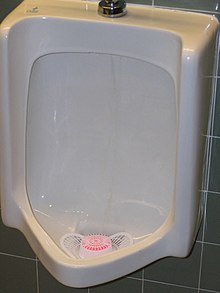
Naphthalene is an organic compound with formula C
10H
8. It is the simplest polycyclic aromatic hydrocarbon, and is a white crystalline solid with a characteristic odor that is detectable at concentrations as low as 0.08 ppm by mass. As an aromatic hydrocarbon, naphthalene's structure consists of a fused pair of benzene rings. It is the main ingredient of traditional mothballs.
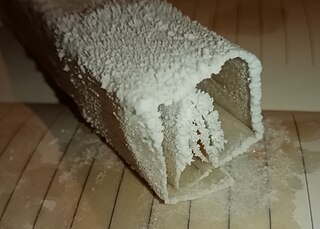
1,4-Dichlorobenzene (1,4-DCB, p-DCB, or para-dichlorobenzene, sometimes abbreviated as PDCB or para) is an aryl chloride and isomer of dichlorobenzene with the formula C6H4Cl2. This colorless solid has a strong odor. The molecule consists of a benzene ring with two chlorine atoms (replacing hydrogen atoms) on opposing sites of the ring.

Mothballs are small balls of chemical pesticide and deodorant, sometimes used when storing clothing and other materials susceptible to damage from silverfish, mold or moth larvae.
A plumbing fixture is an exchangeable device which can be connected to a plumbing system to deliver and drain water.
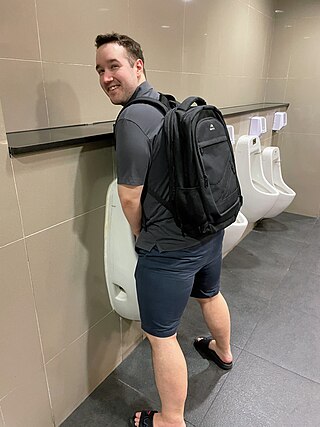
A urinal is a sanitary plumbing fixture for urination only. Urinals are often provided in public toilets for male users in Western countries. They are usually used in a standing position. Urinals can be with manual flushing, automatic flushing, or without flushing, as is the case for waterless urinals. They can be arranged as single sanitary fixtures or in a trough design without privacy walls. Urinals designed for females also exist but are rare. It is possible for females to use stand-up urinals using a female urination device.
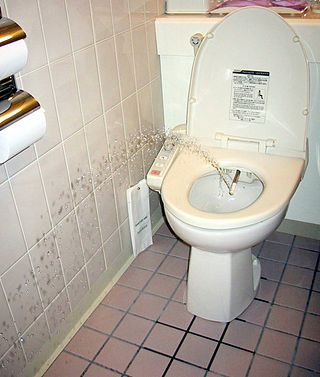
Toilets in Japan are sometimes designed more elaborately than toilets commonly seen in other developed nations. European toilets occasionally have a separate bidet whilst Japan combines an electronic bidet with the toilet. The current state of the art for Western-style toilets in Japan is the bidet toilet, which as of March 2016 is installed in 81% of Japanese households. In Japan, these bidets are commonly called washlets, a brand name of Toto Ltd., and they may include many advanced features rarely seen outside of Asia. The basic feature set commonly found on washlets consists of anal hygiene, bidet washing, seat warming, and deodorization.
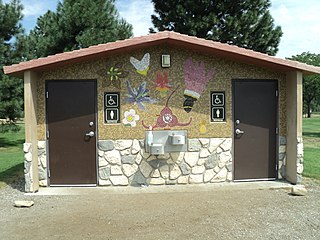
A public toilet, restroom, public bathroom or washroom is a room or small building with toilets and sinks for use by the general public. The facilities are available to customers, travelers, employees of a business, school pupils or prisoners and are commonly separated into male and female toilets, although some are unisex, especially for small or single-occupancy public toilets, public toilets are sometimes accessible to people with disabilities. Depending on the culture, there may be varying degrees of separation between males and females and different levels of privacy. Typically, the entire room, or a stall or cubicle containing a toilet, is lockable. Urinals, if present in a male toilet, are typically mounted on a wall with or without a divider between them. Local authorities or commercial businesses may provide public toilet facilities. Some are unattended while others are staffed by an attendant. In many cultures, it is customary to tip the attendant, especially if they provide a specific service, such as might be the case at upscale nightclubs or restaurants.

Air fresheners are products designed to reduce unwanted odors in indoor spaces, or to introduce pleasant fragrances, or both. They typically emit fragrance to mask odors, but may use other methods of action such as absorbing, bonding to, or chemically altering compounds in the air that produce smells, killing organisms that produce smells, or disrupting the sense of smell to reduce perception of unpleasant smells.

A chemical toilet collects human excreta in a holding tank and uses chemicals to minimize odors. They do not require a connection to a water supply and are used in a variety of situations. These toilets are usually, but not always, self-contained and movable. A chemical toilet is structured around a relatively small tank, which requires frequent emptying. It is not connected to a hole in the ground, nor to a septic tank, nor is it plumbed into a municipal system leading to a sewage treatment plant. When the tank is emptied, the contents are usually pumped into a sanitary sewer or directly to a treatment plant.
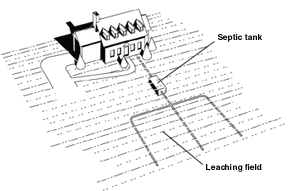
Septic drain fields, also called leach fields or leach drains, are subsurface wastewater disposal facilities used to remove contaminants and impurities from the liquid that emerges after anaerobic digestion in a septic tank. Organic materials in the liquid are catabolized by a microbial ecosystem.
A grinder pump is a wastewater conveyance device. Waste from water-using household appliances flows through the home’s pipes into the grinder pump’s holding tank. Once the wastewater inside the tank reaches a specific level, the pump will turn on, grind the waste into a fine slurry, and pump it to the central sewer system or septic tank.
A urine collection device or UCD is a device that allows the collection of urine for analysis or for purposes of simple elimination. UCDs of the latter type are sometimes called piddle packs.
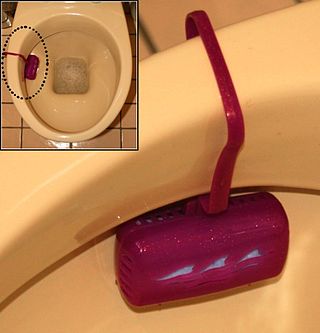
A toilet rim block is a substance in the shape of a block that is used in flush toilets, which slowly dissolves in water. The blocks usually come in a small holder that is attached over the rim of a toilet and hangs down into the bowl, so as the toilet gets flushed, the water passes through the holder coming into contact with the block. With "liquid rims", however, liquid is held in a small bottle above—and connected to—the holder that slowly releases into the bottom of the holder, and so coming into contact with the water when the toilet is flushed.

Cleaning agents or hard-surface cleaners are substances used to remove dirt, including dust, stains, foul odors, and clutter on surfaces. Purposes of cleaning agents include health, beauty, removing offensive odor, and avoiding the spread of dirt and contaminants to oneself and others. Some cleaning agents can kill bacteria and clean at the same time. Others, called degreasers, contain organic solvents to help dissolve oils and fats.
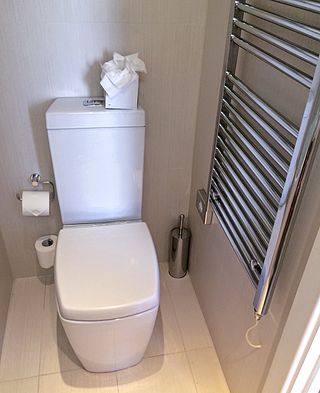
A toilet is a piece of sanitary hardware that collects human urine and feces, and sometimes toilet paper, usually for disposal. Flush toilets use water, while dry or non-flush toilets do not. They can be designed for a sitting position popular in Europe and North America with a toilet seat, with additional considerations for those with disabilities, or for a squatting posture more popular in Asia, known as a squat toilet. In urban areas, flush toilets are usually connected to a sewer system; in isolated areas, to a septic tank. The waste is known as blackwater and the combined effluent, including other sources, is sewage. Dry toilets are connected to a pit, removable container, composting chamber, or other storage and treatment device, including urine diversion with a urine-diverting toilet.

Urine diversion, also called urine separation or source separation, refers to the separate collection of human urine and feces at the point of their production, i.e. at the toilet or urinal. Separation of urine from feces allows human waste to be treated separately and used as a potential resource. Applications are typically found where connection to a sewer-based sanitation system is not available or areas where water supplies are limited.
Ekam Eco Solutions is an Indian startup company that markets products related to ecological sanitation and sustainable living. The company is best known for its Zerodor waterless urinal technology and CARE Natural Housekeeping & Home Care Solutions.
A deodorizing toilet seat is a toilet seat that comes with integrated air purifier and air freshener solutions to combat bad odors.
Chemical drain cleaners or openers are pure or mixtures of chemicals used to unclog drains that are blocked by hair, food, or other organic materials. They are often accompanied by other mechanical drain cleaners for the optimal effect. Chemical drain cleaners are available through hardware stores, although some may be intended for use by licensed plumbers. They may contain either strong acids or strong alkalis. These cleaners contain chemicals that dissolve at least some of the material causing the clog.
